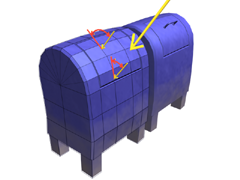Materials work in combination with lights. The intensity of light that falls on a surface determines the intensity of color to display.
Three factors contribute to the intensity of light where it falls on an object:
- Light intensity: A light's original intensity at its point of origin.
- Angle of incidence: The more a surface inclines away from the light source, the less light it receives and the darker it appears. The angle between a ray of light and the face normal of a surface is the angle of incidence for that face.
When the angle of incidence is 0 degrees (that is, the light strikes the face perpendicularly), the face is illuminated at full intensity unless the light is attenuated. Full intensity is the light's Multiplier value times the value of the face's surface color. The Multiplier value is 1.0 by default; the surface value is the Value component of the surface color's HSV description. As the angle of incidence increases, the intensity of the face illumination decreases.

Angle of incidence affects intensity.
- Distance: Light diminishes over distance. This effect is known as attenuation.
Photometric lights always attenuate at the real-world inverse square rate.
By default, standard lights do not attenuate, but you can turn on attenuation and specify the attenuation rate and the distance over which it operates.